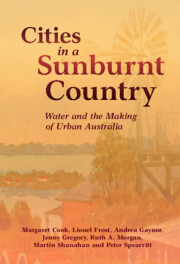Book contents
- Cities in a Sunburnt Country
- Studies in Environment and History
- Cities in a Sunburnt Country
- Copyright page
- Contents
- Figures
- Maps
- Book part
- Tables
- Acknowledgements
- 1 Prologue
- 2 Living Water
- 3 Domesticating Water
- 4 Keeping Up
- 5 Transforming Homes
- 6 Watering Suburbia
- 7 Crises of Confidence
- 8 Twenty-First Century Australian Cities
- 9 Epilogue
- References
- Index
- Studies in Environment and History
8 - Twenty-First Century Australian Cities
Published online by Cambridge University Press: 19 May 2022
- Cities in a Sunburnt Country
- Studies in Environment and History
- Cities in a Sunburnt Country
- Copyright page
- Contents
- Figures
- Maps
- Book part
- Tables
- Acknowledgements
- 1 Prologue
- 2 Living Water
- 3 Domesticating Water
- 4 Keeping Up
- 5 Transforming Homes
- 6 Watering Suburbia
- 7 Crises of Confidence
- 8 Twenty-First Century Australian Cities
- 9 Epilogue
- References
- Index
- Studies in Environment and History
Summary
At the beginning of the new millennium, Australia's cities and their peri-urban and rural hinterlands were in the midst of a worsening drought. Having developed in the mid-1990s, the Millennium Drought finally broke in 2010, at least in south-eastern Australia. It was the most severe drought experienced in southern Australia since instrumental records began in the early twentieth century, thanks to a combination of natural variability and anthropogenic climate change. The urgency of water restrictions and supply augmentation that had characterised the drought years gave way to more pressing matters of the electoral cycle. As Australian cities continue to grow, it remains be seen as to whether plans to shape the urban form as a water catchment of its own materialise beyond model suburbs and local initiatives and what their implementation might mean for the water infrastructure and cultures of the past.
Keywords
- Type
- Chapter
- Information
- Cities in a Sunburnt CountryWater and the Making of Urban Australia, pp. 198 - 230Publisher: Cambridge University PressPrint publication year: 2022



